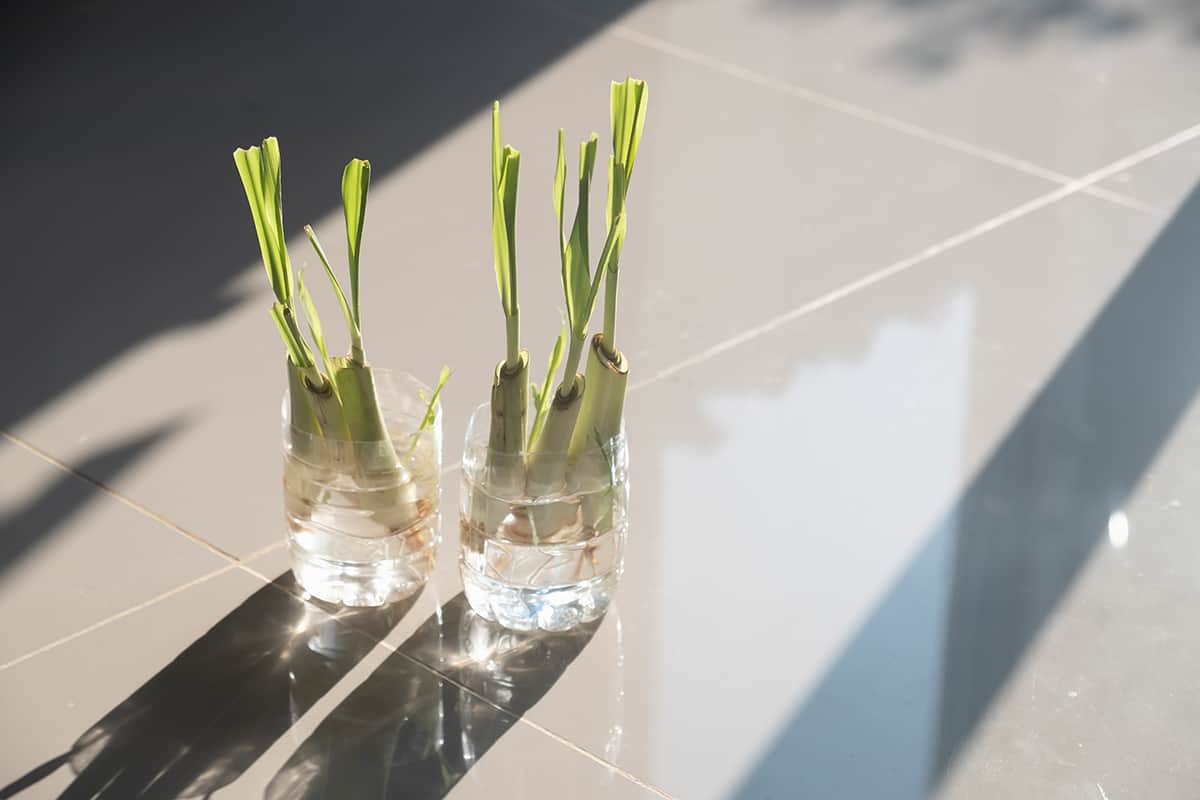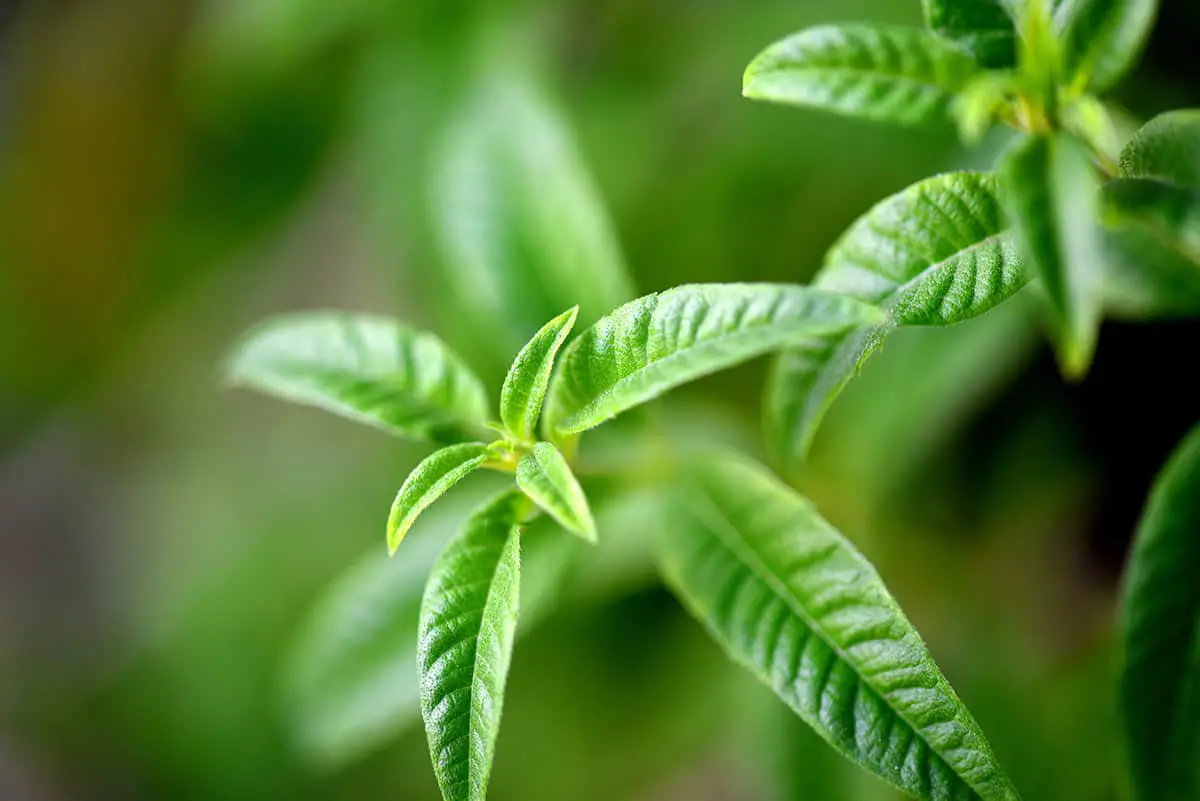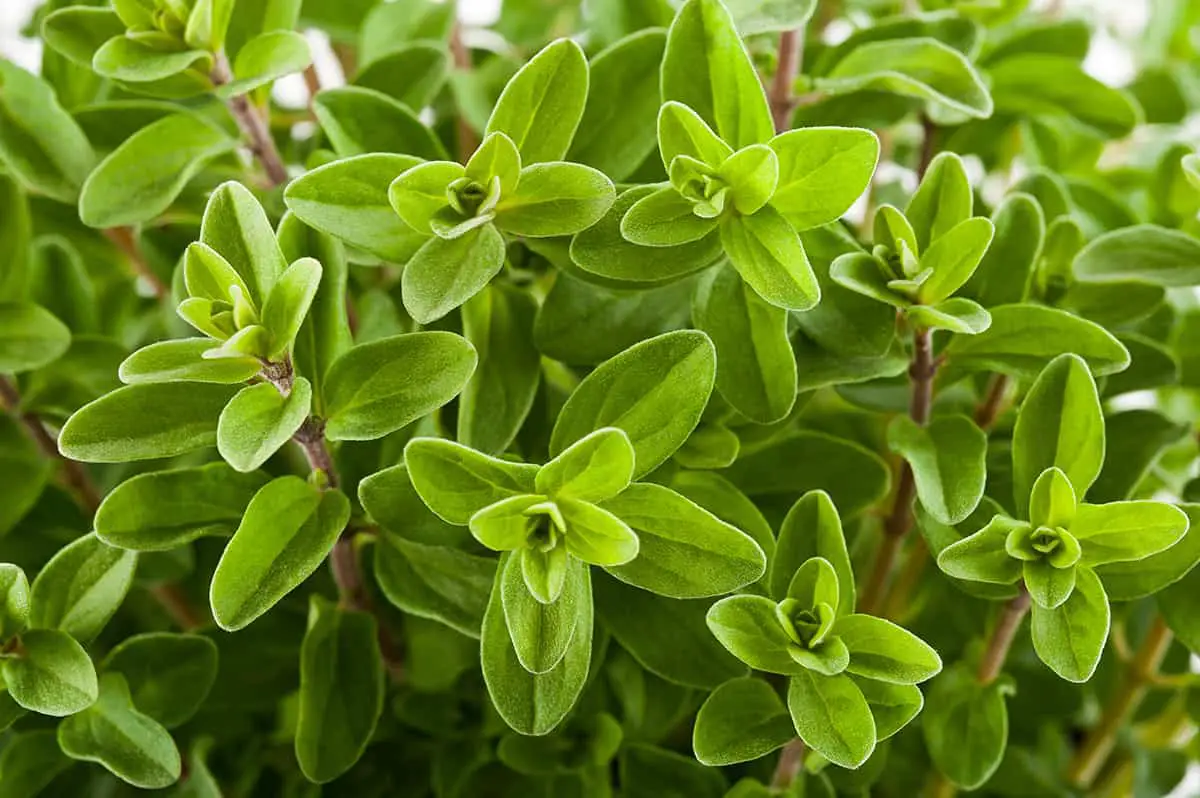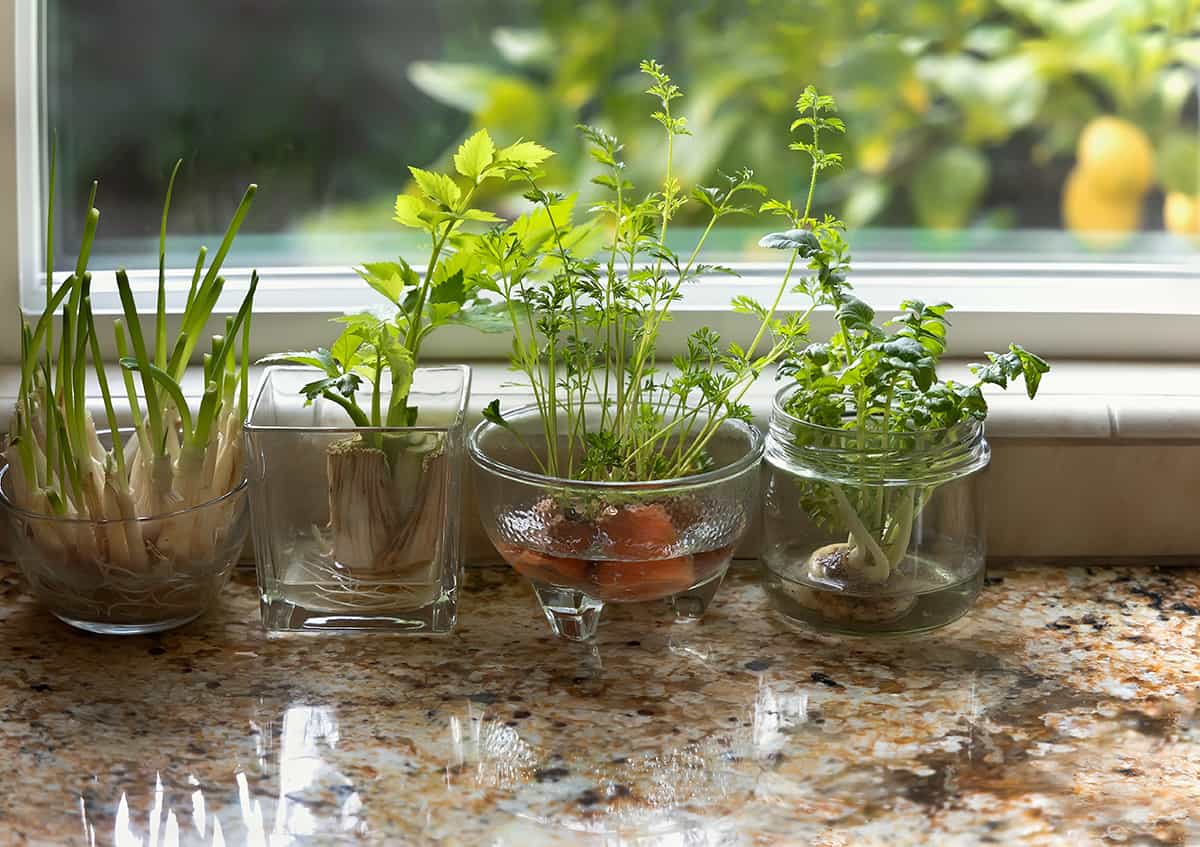Growing herbs in water is a popular and convenient method for gardeners of all skill levels. You can easily maintain a fresh supply of aromatic and flavorful herbs right in your kitchen. With no soil required, this mess-free and pest-free approach allows you to enjoy your favorite herbs all year round.
Many herbs can successfully grow in water, and some even thrive better when propagated from cuttings. To get started, simply place stem cuttings with leaf nodes in a container filled with water, positioning it in a location with good light. Soon, you’ll have a beautiful, functional, and easy-to-maintain indoor herb garden at your fingertips.
Table of Contents
Basil

Basil is an excellent herb to grow in water. Take several cuttings from an existing plant, leaving 2-3 sets of leaves on top. Remove any flowers or lower leaves that will be submerged in water.
Place the cuttings in a transparent glass jar with non-chlorinated water. Ensure that only 60-70% of the stem is submerged. Basil cuttings can thrive in water for weeks or months, and you’ll enjoy a never-ending supply of fresh basil.
Maintain your basil by changing the water frequently and placing the container in a location that receives indirect sunlight. Check for roots, which should develop within a week or two. Once established, your basil will be ready for use in delicious recipes.
Cilantro

Cilantro is a flavorful herb that can grow easily in water. First, you’ll need cilantro seeds. Opt for the “slow-bolt” variety for best results. Place the seeds in a container filled with water.
Keep the container in a well-lit area, such as a sunny windowsill. Regularly change the water to keep it fresh and clean. It’s essential for encouraging root growth and preventing fungus buildup. In no time, your cilantro plant will start growing.
Growing cilantro in water has advantages. It eliminates the need for soil and keeps your herb free from soil-borne pests. Moreover, it allows for year-round growing, ensuring a fresh supply of cilantro at your fingertips.
Maintenance is minimal. Simply harvest the leaves as needed and propagate new plants from cuttings to keep your water-based cilantro garden going.
Mint

Mint adds flavor to a variety of beverages and dishes. With mint grown in water, you can enjoy this fresh herb year-round.
To start, take a few 4-6 inches of mint sprigs or cuttings from a healthy mint plant. Place them in a glass container with sufficient water. Make sure the water level is just below the lowest leaves. A well-lit area, such as a windowsill, makes the perfect spot for your mint growing in water.
Change the water every few days to prevent any bacterial growth. Observe the cuttings for root development. Mint cuttings are known to develop roots within a week or two.
Once the roots emerge, your mint plant will continue to grow and thrive in water. Remember to trim it regularly, and you’ll have a continuous supply of fresh mint for your tea, fruit salads, and other culinary delights.
Lavender

Lavender is a wonderful herb to grow at home, and you might be surprised to learn that it can also be grown in water. For optimal results, choose semi-hardwood cuttings from a healthy lavender plant. When selecting the cutting, opt for a younger one with fresh growth for a higher chance of success.
To start, grab a clean glass jar or vase and fill it with water. Avoid using tap water, as it may contain chlorine and fluoride, which could hinder the growth of your lavender. Instead, opt for filtered or distilled water to ensure a healthy environment for your cutting. Place the cutting in the water and make sure the bottom part is submerged while the leaves remain above water level.
Position your lavender cutting in a spot with plenty of indirect sunlight. Direct sunlight might cause the water to become too warm, which can adversely affect the cutting’s growth. Ensure that you regularly change the water to keep it clean and fresh, as this helps prevent algae and bacteria buildup.
In a few weeks, you’ll notice that roots have started to develop. When they’re around an inch long, you can transfer the rooted lavender cutting to a pot with soil or hydroponic medium.
Lemongrass

Lemongrass is an easy-to-grow herb that can be grown in water. This method is mess-free and pest-free, making it an ideal choice for an indoor garden. To begin, you’ll need a healthy, mature lemongrass plant to take a cutting from.
Cut a five to six-inch stem from the bottom of the plant. Place the cutting in a bowl filled with water, keeping at least half of the cutting above the water line. Avoid letting the cutting become fully submerged.
Once the lemongrass stalk is in water, it may take two to three weeks to develop roots. During this time, you will see new leaves growing from the top of the stalk while new roots sprout from the bottom. For optimal growth, ensure the temperature is between 77-86°F (25-30°C).
Growing lemongrass in water provides a fresh, delicious herb readily available for your culinary needs. With its distinctive flavor and aroma, lemongrass is a popular addition to many dishes, particularly in Asian cuisine.
Lemon Verbena

Lemon Verbena, known as Aloysia triphylla, is a fragrant herb valued for its medicinal uses and delightful scent. You can grow it successfully in your home herb garden. Here’s how you can grow this wonderful herb in water.
First, choose a healthy Lemon Verbena cutting with a few leaves attached. Next, remove any lower leaves that might touch the water, as they can rot. Fill a glass or jar with clean water and place the cutting in it. Be sure to change the water frequently to prevent bacterial growth, and keep the container in a well-lit area.
Growing herbs in water is not only an attractive addition to your home, but it also allows you to easily harvest herbs for culinary or medicinal purposes. Lemon Verbena, for instance, is used to make tea.
Remember, while Lemon Verbena can be grown in water, it’s important to transplant the herb into the soil eventually once it develops roots. This ensures the plant receives the nutrients it needs to thrive and continues offering you its delightful properties.
Marjoram

Marjoram (Origanum majorana) is an aromatic herb that can be grown in water. It is popular for its delicate flavor, suitable for various dishes. Hydroponic marjoram is a simple and efficient method of cultivation.
In order to grow marjoram in water, you need stem cuttings from a healthy plant. Place these cuttings in a container, like a rock glass or short glass tumbler, that has at least 4 inches of height. Fill the container with water, ensuring the nodes of the cutting are submerged.
Make sure the container is stable and heavy to support the herb as it grows. Keep the marjoram in a location that receives adequate sunlight. When grown indoors, move the plant outside to a sunny area during mild weather. Regularly check the water level and refill as needed. Marjoram is a hardy herb that does not require fertilizer.
Oregano

To grow oregano in water, start with a healthy cutting from an existing plant. Remove any leaves from the bottom 1-2 inches and place the cutting in a container filled with water. Change the water every few days to prevent stagnation.
Monitoring the development is essential for success. After a few weeks, your oregano cutting should have roots. Ensure that your oregano gets adequate sunlight and minerals to help it thrive. You can also transfer the plant to a pot with soil if desired.
Once established, your oregano plant will be a great addition to your homegrown herbs collection. Whether using it for culinary purposes or as an ornamental element, oregano will make your indoor garden attractive and practical.
Rosemary

Rosemary is a popular herb for its culinary uses and aromatic qualities. You may not know that rosemary can be grown in water, making it an easy addition to your indoor garden.
To grow rosemary in water, take a cutting from a healthy plant. Choose a green stem about 4 to 6 inches long and remove the lower leaves. Place the stem in a glass container with fresh water, making sure the cut end is submerged. Keep it on a sunny windowsill and change the water every few days to prevent algae growth.
Rosemary flourishes in temperatures between 20 and 25°C (68 and 77°F). Ensure it receives at least 6 hours of direct sunlight daily. Once the roots grow to about two inches in length, you can transplant them into a pot with well-draining soil or keep growing them in water.
Parsley

Growing parsley in water is an excellent method for enjoying this popular herb year-round. As a hydrophyte, parsley can develop strong roots and thrive in a water environment. With the right conditions, you can have a lush, indoor harvest of parsley. For successful growth, select healthy plants with strong stems and vibrant green leaves.
To start the process, simply snip a healthy stem with a clean pair of sharp shears. Place the cutting in a glass jar filled with filtered water. It’s best to let tap water sit overnight before using it, but avoid using distilled water as it lacks nutrients your parsley plant requires for growth. Make sure the leaves don’t touch the water to avoid rot.
Sage

To grow sage in water, simply take a cutting from a healthy sage plant, ensuring it has a few leaf nodes. Then, place the cutting in a container filled with water and make sure it’s getting enough light.
As sage plants can grow in water without soil, they still need nutrients to thrive. To maintain the plant’s health, add a hydroponic nutrient solution that’s specifically formulated for herbs. This ensures your sage plant receives all essential minerals and trace elements needed.
Growing sage in water allows you to have a continuous supply of this versatile herb. It’s perfect for culinary purposes, medicinal uses, and simply enjoying the pleasant aroma it provides. Remember to change the water regularly and monitor the plant’s growth to keep it healthy.
Thyme

Thyme is a versatile and popular herb that you can easily grow in water. With its delicate flavor, it is perfect for cooking poultry, fish, and vegetables. This method provides a mess-free, pest-free way to enjoy fresh thyme year-round.
To start growing thyme in water, first take cuttings from a mature plant. Make sure to select a healthy stem with several leaf nodes. After cutting, remove the lower leaves and immerse the stem in a container filled with water.
Place the container in a spot that receives plenty of natural light. Change the water every few days to maintain freshness and prevent bacterial growth. Thyme can grow for months in water, allowing you to harvest fresh leaves as needed.
Incorporating thyme into your cooking adds depth and complexity to your dishes. Some popular uses for thyme include seasoning roasted vegetables, flavoring meat dishes, and infusing oils.






